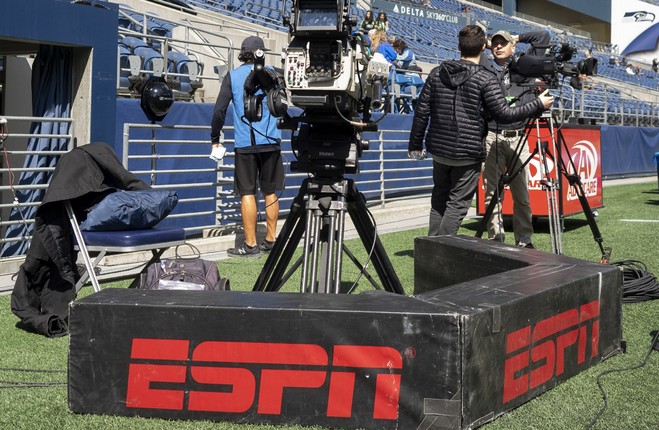1. When Pitaro was appointed president in March 2018, he saw internal data that showed a significant gap between how Republicans and Democrats viewed ESPN’s on-air talent and the entertainment value of the production. He held a series of town halls with employees and stressed in public comments that politics would be discussed at ESPN only through the lens of sports. The network also says its research finds that fans, regardless of political affiliation, do not want to hear about politics on ESPN.
The results weren’t necessarily drastic; ESPN was never covering immigration policy to begin with. But Le Batard’s recent comments notwithstanding, fewer ESPN reporters and hosts are tweeting about Trump now, while some programs on the daytime lineup have pared back opinions to focus more on highlights.
The Washington Post takes a look at how ESPN are dealing with America’s berserk political moment….
2. The problem is that the new normal is not normal at all. America has an end of days feel to it at the moment. A troubled place where the country is no longer divided between Democrats and Republicans but, in a way that often crosses traditional party lines, between sentient humans and the amoeba slinking after Trump and wallowing in the hatred he spews. Stark as it may sound, there are those who want to be on the right side of history and those who will eventually be judged to have collaborated with the darkest regime.
“I always turn to the sports section first,” said US Supreme Court Justice Earl Warren. “The sports section records man’s accomplishments; the front page has nothing but man’s failures.”
Times have changed. The accomplished men are calling out the failures. All over the place. Except on ESPN.
…and the Irish Times’ Dave Hannigan tells them why they’re wrong.
3. For two decades, the decline of bowling leagues has been a sociologist’s shorthand for the crack-up of American civic society. GoBowling.com’s tagline—“the original social network”—sounds a little like a person deciding late in life to be extremely online.
But two things changed, putting bowlers like Troup in a different light. Viewers watching his climactic roll on FS1 saw more than the old shot of the ball traveling up the lane. Fox put a red tracer on the ball, like they do tee shots at the U.S. Open. So viewers followed Troup’s ball as it started right, flirted with the gutter, and then broke at the sixth board before making its journey to the “pocket” between the 1 and 3 pins. Viewers knew Troup’s ball reached a speed of 19.4 miles per hour (very fast) and moved at a rate of 504 revolutions per minute (very powerful). All the data gave an analytics-friendly spin to Troup’s proclamation that “I just dead-laced it.”
Bryan Curtis of The Ringer takes a look at how Fox Sports are hoping to leverage the Big Lebowski and bring eyeballs to bowling.
4. Even with two good knees and a full playing career, he would still have told Bremner, Giles and Hunter where they could throw their medals. And, even if he had poked the ball beyond Chris Harker and hurdled his challenge, he would still have existed in a different world to anyone who worked at the FA.
Instead, the injury’s influence was largely logistical. It provided the time and opportunity to coach Sunderland’s A team – a stop-gap which seemed to create a conviction in his management abilities – and would also eventually align with Taylor.
Inadvertently, it launched his second career at the perfect moment.
Writing for Football365, Seb Stafford-Bloor considers the timing and impact of Brian Clough’s premature, career-ending injury as a player.
5. With his wife, Elizabeth, and his 2-year-old son, Daniel, in St. Petersburg, Dadashev lived mostly in Oxnard in a house that Egis maintains for his up-and-coming fighters. Unlike the others, though, he didn’t party or go on sightseeing ventures. He rarely leaves his room. He watches fights on YouTube. He watches American movies: “Scarface,” “The Godfather,” and his favorite, “Jumanji.” They were a great help in learning English, he said last October.
With a full beard, he looked like his moniker, “Mad Max.” A couple of months ago, he had his belly tattooed with the images of Zeus and the Gladiator. “Zeus can do anything,” he said. “And the gladiator can fight.”
But on Thursday, as he came to the fighter meetings almost clean-shaven, Dadashev seemed different, with soft features and a slender neck. He said he was reading children’s books to help him with his English. He was also playing chess “for mental improvement.”
“After this fight, I will send my documents for the green card,” he said.
His wife would be joining him after the fight.
He still had the dream. Sunbathing.
In Miami. Or Hawaii.
Before Maxim Dadashev tragically passed away from his injuries earlier this week, ESPN’s Mark Kriegel wrote a poignant and occasionally haunting profile.

